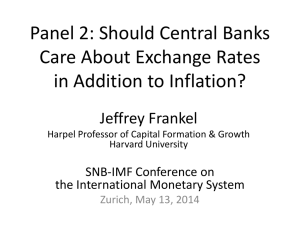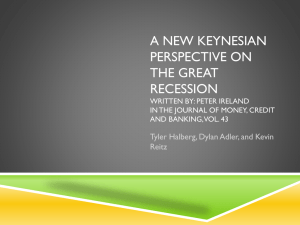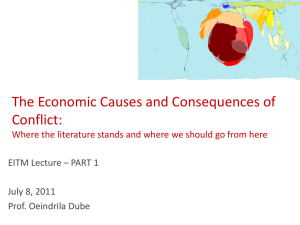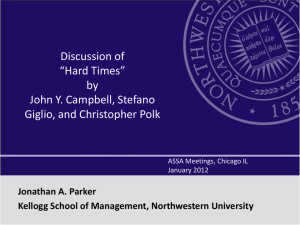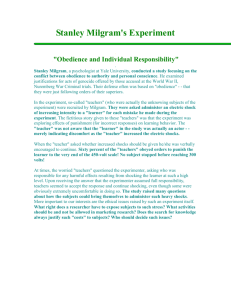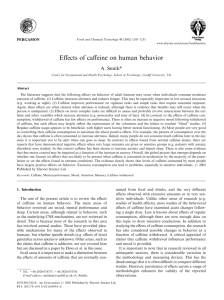Oil and the Macroeconomy
advertisement
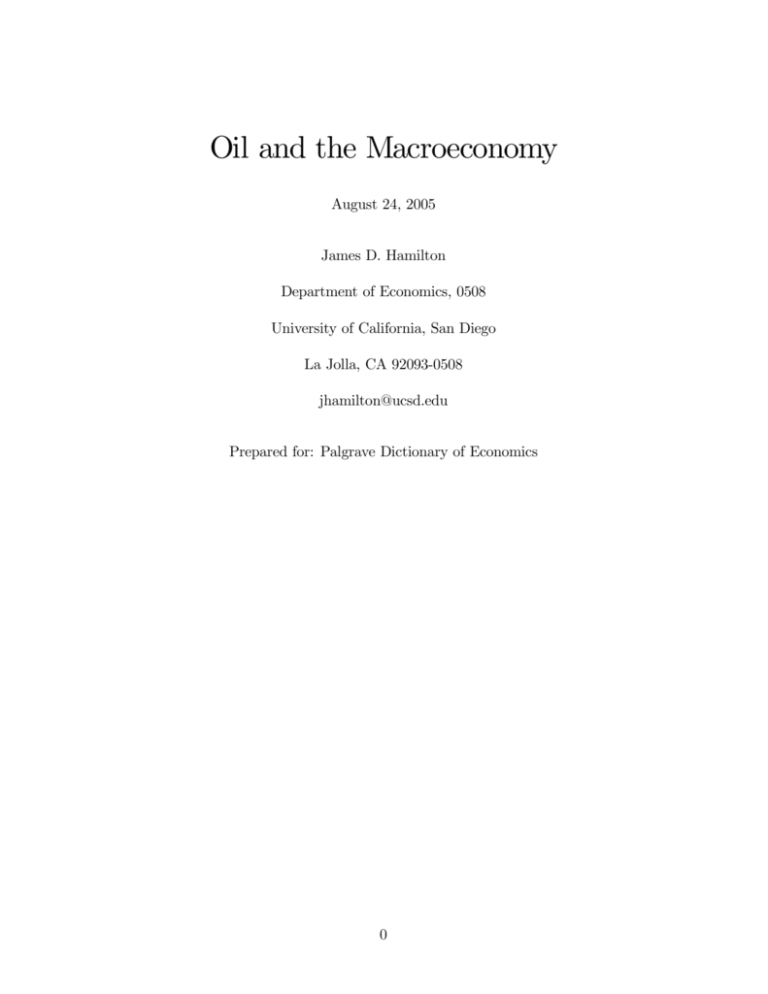
Oil and the Macroeconomy August 24, 2005 James D. Hamilton Department of Economics, 0508 University of California, San Diego La Jolla, CA 92093-0508 jhamilton@ucsd.edu Prepared for: Palgrave Dictionary of Economics 0 Nine out of ten of the U.S. recessions since World War II were preceded by a spike up in oil prices. One way to inquire whether this might be just a coincidence is with a statistical regression of real GDP growth rates (quoted at a quarterly rate) on lagged changes in GDP growth rates and lagged logarithmic changes in nominal oil prices. The results from an OLS estimation of this relation for t = 1949:II to 1980:IV are as follows (standard errors in parentheses): yt = 1.14 + 0.20 yt−1 + 0.05 yt−2 − 0.10yt−3 − 0.19 yt−4 (0.18) (0.09) (0.09) (0.09) (0.09) − 0.004ot−1 − 0.027ot−2 − 0.034ot−3 − 0.065ot−4 . (0.026) (0.026) (0.026) (0.027) The coefficient on the fourth lag of oil prices (ot−4 ) is negative and highly statistically significant (t-statistic = -2.4), and an F -test leads to a rejection of the null hypothesis that the coefficients on lagged oil prices are all zero with a p-value of 0.005. Quite a few studies have tested and rejected the hypothesis that the relation between oil prices and output could just be a statistical coincidence, including Rasche and Tatom (1977, 1981), Hamilton (1983), Burbidge and Harrison (1984), Santini (1985, 1994), Gisser and Goodwin (1986), Rotemberg and Woodford (1996), Daniel (1997), Raymond and Rich (1997), Carruth, Hooker, and Oswald (1998), and Hamilton (2003). Another possibility is that the correlation between oil prices and output results from common dependence on some third factor or factors that are the true cause of both the increase in oil prices as well as the subsequent recession, for example, that something about the last stages of an economic expansion often produces a surge in oil prices. This is difficult 1 to reconcile with the fact that, at least for the early postwar period, oil price changes could not be predicted from earlier movements in other macro variables (Hamilton, 1983), and that most of the oil spikes can be attributed to exogenous events such as military conflicts (Hamilton, 1985). However, challenges to the latter claim have recently been developed by Barsky and Kilian (2002, 2004). Economic theory suggests that it would be the real oil price rather than the nominal price that should matter for economic decisions. It does not make much difference in summarizing the size of any given shock whether one uses the nominal price ot or the real price of oil, since in most of these shocks the move in nominal prices is an order of magnitude larger than the change in overall prices during that quarter. However, particularly in the early part of the sample, the nominal oil price would stay frozen for years and then adjust suddenly. To the extent that there is a difference between using nominal and real prices as the explanatory variable in such regressions, the real price results from the confluence of two forces— events such as the Suez Crisis, which accounts for almost all of the movement in the nominal price between 1955 and 1965, and the quarter-to-quarter change in inflation, which is completely endogenous with respect to the economy and whose consequences for future output are likely to be quite different from those of an oil shock. Insofar as the statistical exogeneity of the right-hand variables is important for interpreting the regression, many researchers have for this reason used the nominal oil price change rather than the real oil price change as the explanatory variable. One simple framework for thinking about what the effects of energy supply disruptions 2 should be comes from examining a production function relating the output Y produced by a particular firm to its inputs of labor N, capital K, and energy E: Y = F (N, K, E). Suppose that output is sold for a nominal price P dollars per unit, labor is paid nominal wage W , energy’s nominal price is Q, and capital is rented at nominal rate r. The profits of the firm are given by P Y − W N − rK − QE. A price-taking profit-maximizing firm would purchase energy up to the point where the marginal product of energy is equal to its relative price, FE (N, K, E) = Q/P, where FE (N, K, E) denotes the partial derivative of F (.) with respect to E. If we multiply both sides of the above equation by E and divide by Y , we find QE ∂ ln F = . ∂ ln E PY In other words, the elasticity of output with respect to a given change in energy use can be inferred from the dollar share of energy expenditures in total output. This dollar share for the economy as a whole is fairly small. the U.S. consumed about 7.2 billion barrels of oil. For example, in 2000 At a price of $30 a barrel, that only represents 2.2% of a $9.8 trillion nominal GDP. With the rapid price increases of the last few years, the fraction is up to 3.8% of GDP. 3 Table 1 reports Hamilton’s (2003) values for the size of the supply disruptions associated with the five most important oil shocks, calculated from the magnitude of the drop in production in the affected countries. Kilian (2005) has more modest estimates based on his inference that production might have fallen even in the absence of the indicated events, and neither Hamilton’s nor Kilian’s figures take into account the fact that typically production increased in other parts of the world to make up part of the gap. Even using the 10% figure and a 4% crude oil share, however, such shocks would by the above calculation be predicted to reduce GDP by only 0.4%. The table also reports the amount by which U.S. real GDP declined between the date of the oil shock and the trough of the subsequent recession, which trough usually was reached a little over a year after the oil shock. Since the U.S. economy would grow 3.4% during a typical year, these numbers imply declines of real GDP relative to trend in excess of 4.0%, an order of magnitude greater than predicted by the factor share argument. Furthermore, Bohi (1991) failed to find statistically significant evidence that industries with greater energy factor shares suffered more than others in response to the oil shocks of the 1970’s. One would arrive at a similar prediction if one thought of the oil shock as an exogenous change in the price of oil rather than a decrease in the quantity supplied. Faced with an increase in fuel costs, one option a given consumer would always have would be to keep on buying as much gas as before but just pay the higher price. decreasing other expenditures as needed. The value of what you lose if you behave in this way is given by E · ∆Q, or, expressing this relative to your total income P Y, E · ∆Q QE ∆Q = · , PY PY Q 4 in other words, the percentage change in oil prices ∆Q/Q is again multiplied by energy’s value share QE/P Y. This actually places an upper bound on the value of what the consumer loses, because, insofar as the consumer opts to reduce E rather than hold E fixed, it must be because the latter strategy is in fact an inferior option. If these oil shocks did contribute to economic downturns, it would have to be attributed to the movements they induced in other factors of production rather than the value of the lost energy input per se. There would be some modest adjustments of other factors anticipated in a frictionless neoclassical model, but these appear to be small. Kim and Loungani’s (1992) real business cycle analysis suggested that oil price shocks could explain only a modest component of the variance of U.S. output growth. One modification that can make a difference is to replace the assumption of perfect competition with mark-up pricing. Rotemberg and Woodford (1996) showed that this can induce a response of labor utilization to an oil price shock that greatly amplifies the effects, with simulations in which a 10% increase in energy prices could lead to a 2.5% drop in output 6 quarters later. Another important margin is the capital utilization rate, as emphasized by Finn (2000), who was able to arrive at similar quantitative effects as Rotemberg and Woodford even under the assumption of perfect competition. Another explanation for the correlation between energy prices and output that has been offered has to do with the role of monetary policy. Barsky and Kilian (2002, 2004) argued that a monetary expansion was the cause of much of the 1973-74 oil price increase, and that 5 this monetary expansion also set the stage for a subsequent decline in output. Bernanke, Gertler and Watson (1997) took the view that the oil shocks were exogenous, but the Federal Reserve responded to them by raising interest rates in order to control inflation, with this monetary contraction itself the principal cause of the downturns. Hamilton and Herrera (2004) argued that the Bernanke, Gertler, and Watson conclusion was due primarily to the fact that these authors omitted the biggest effects of oil shocks corresponding to the coefficients on ot−3 and ot−4 in the regression above. Leduc and Sill (2004) added sticky prices to a theoretical model generalizing the approach considered by Finn (2000), and concluded that monetary policy makes only a modest contribution. More empirically oriented studies also concluding that the oil shocks were more important than any monetary contraction include Dotsey and Reid (1992), Hoover and Perez (1994), Ferderer (1996), Brown and Yücel (1999), and Davis and Haltiwanger (2001). A different class of explanations emphasizes the frictions in reallocating labor or capital across different sectors that may be differentially affected by an oil shock. For example, one common consequence of an oil price shock is a sudden drop in demand for certain kinds of cars, which leads to lower capacity utilization at affected plants (Bresnahan and Ramey, 1993). Because labor and capital cannot move costlessly to alternative productive activities, the result is idle resources that can significantly multiply the effects described above. Manufacturing of transportation equipment is one of the industries most affected by oil shocks in the U.S. but with one of the lowest energy intensities, and thus is part of the reason that Bohi (1991) found no connection between energy intensity and output 6 decline. Lee and Ni (2002) found that oil price shocks tend to reduce supply in oil-intensive industries but reduce demand in other industries such as autos. Davis and Haltiwanger (2001) found oil shocks reduce employment the most in industries that are more capital intensive, more energy intensive, and have greater product durability. Keane and Prasad (1996) documented significant differences across industries in the effects of oil shocks on workers’ wages. Hamilton (1988) and Atkeson and Kehoe (1999) provided theoretical analyses of the way in which technological costs of adjusting capital or labor can result in magnification of the disruptive effects of oil shocks. One of the key predictions of such models is that, unlike the factor share stories, the response of output to oil prices would not be log-linear. When oil prices go up, consumers may postpone their car purchases, but when oil prices go down, they do not go out and buy a second car. In fact, it is a theoretical possibility that, as a result of the output that is lost from trying to reallocate capital and labor, the short-run effect of an oil price decrease would actually be a decline rather than an increase in output. If one estimates a log linear relation between GDP growth and lagged oil prices, the statistical significance of the relation falls as one adds more data (Hooker, 1996), suggesting at a minimum that a linear relation is either misspecified or unstable. For example, when the regression described above is re-estimated with data through 2005:II, the result is yt = 0.69 + 0.28 yt−1 + 0.13 yt−2 − 0.07yt−3 − 0.12 yt−4 (0.11) (0.07) (0.07) (0.07) (0.07) − 0.003ot−1 − 0.006ot−2 − 0.002ot−3 − 0.015ot−4 . (0.006) (0.006) (0.006) (0.006) Although the t-statistic on ot−4 remains statistically significant with a p-value of 0.02, an 7 F -test of the null hypothesis that all four coefficients on lagged oil prices are zero would be accepted with a p-value of 0.11. The size of the effect is substantially smaller as well— whereas the 1949-80 regression would predict that GDP growth would be 2.9% slower (at an annual rate) four quarters after a 10% oil price hike, the 1949-2005 regression would predict only 0.7% slower growth. A number of authors have concluded that this instability is due to nonlinearity of the relationship, with a linear relationship breaking down empirically when the huge oil price drops of 1985 failed to produce an economic boom. Loungani (1986) and Davis (1987a,b) were the first to report evidence of nonlinearity of these relations, which they interpreted as implying that the effects of oil shocks resulted from sectoral shifts with costly reallocation of resources. Mork (1989) estimated separate coefficients on oil price increases and decreases, and found that the latter were statistically insignificantly different from zero. To the extent that the oil shocks are operating through an effect on demand for items such as less fuel-efficient cars, the influence would depend not just on the size of the oil price increase but also the context in which it occurred. Lee, Ni, and Ratti (1995) found that much better forecasts of GDP growth were obtained if one divided the oil price increase by the standard deviation of recent price volatility. Hamilton (2003) used a flexible parametric model to investigate the nature of this nonlinearity, and found support for the Lee, Ni, and Ratti formulation as well as an alternative that looks at how much the oil price might exceed its previous 3-year peak; if it does not exceed the previous 3-year peak, no oil shock is said to have occurred. An OLS regression of quarterly GDP growth (quoted at a quarterly rate) 8 on lags of this net oil price measure for 1949:II to 2005:II results in the following estimates: yt = 0.87 + 0.24 yt−1 + 0.11 yt−2 − 0.08yt−3 − 0.13 yt−4 (0.12) (0.07) (0.07) (0.07) (0.07) # # # − 0.009o# t−1 − 0.014ot−2 − 0.009ot−3 − 0.031ot−4 . (0.012) (0.012) (0.012) (0.012) Here an F -test of the null hypothesis that all coefficients are zero is rejected with a p-value of 0.006, and a 10% increase in oil prices above their previous 3-year high is predicted to reduce quarterly GDP growth (quoted at an annual rate) by 1.4%. Similar evidence of nonlinearity, with oil price increases reducing real output growth, have also been reported for a number of other countries by Mork, Olsen, and Mysen (1994), Cuñado and Pérez de Gracia (2003), and Jimenez-Rodriguez and Sanchez (2005). As noted by Kilian (2005), civil unrest in Venezuela in December 2002 led to a drop in production of 2.3 million barrels a day, representing 3.4% of world production at the time. The net oil price series o# t reflected a surge in crude oil prices 20% above their previous 3-year high. Nevertheless, there was no discernible drop in GDP. Another surge in o# t of 18% occurred in 2004:III, accompanied by a 1.3% increase in world production, and a third surge of 21% in 2005:I, accompanied by a 0.2% increase in production, with no recession as of the time of this writing. It is clear from the last two examples in particular that demand increases rather than supply reductions have been the primary factor driving oil prices over the last several years. Insofar as these demand increases resulted from global income growth, one wouldn’t expect to see the sharp drop in consumer spending on other key items that accompanied the episodes in Table 1. At a minimum, the failure of a recession to result as of the time of this writing from the oil price increases of 2003-2005 suggests that there is 9 not simply a mechanical relation, even a nonlinear one, between oil prices and output. The experience is consistent with the claim that the key mechanism whereby oil shocks affect the economy is through a disruption in spending by consumers and firms on other goods and that, if this disruption fails to occur, the effects on the economy are indeed governed by the factor share argument. Another potential macroeconomic effect of oil price shocks is on the inflation rate. The long-run inflation rate is governed by monetary policy, so ultimately this is a question about how the central bank responds to the oil shock. Hooker (2002) found evidence that oil shocks made a substantial contribution to U.S. core inflation before 1981 but have made little contribution since, consistent with the conclusion of Clarida, Galí and Gertler (2000) that U.S. monetary policy has become significantly more devoted to curtailing inflation. 10 Table 1 Exogenous disruptions in world petroleum supply. ––––––––––––––––––––––––––––––––––––— Date Event Drop in world production Drop in U.S. real GDP Nov. 1956 Suez Crisis 10.1% -2.5% Nov. 1973 Arab-Israel War 7.8% -3.2% Nov. 1978 Iranian Revolution 8.9% -0.6% Oct. 1980 Iran-Iraq War 7.2% -0.5% Aug. 1990 Persian Gulf War 8.8% -0.1% ––––––––––––––––––––––––––––––––––––— Source: Hamilton (2003). 11 Atkeson, Andrew, and Patrick J. Kehoe (1999), “Models of Energy Use: Putty-Putty Versus Putty-Clay,” American Economic Review, 89, 1028-1043. Barsky, Robert B., and Lutz Kilian (2002). “Do We Really Know that Oil Caused the Great Stagflation? A Monetary Alternative,” in Ben S. Bernanke and Ken Rogoff, eds., NBER Macroeconomics Annual 2001, MIT Press: Cambridge, MA, pp. 137-183. _____ (2004). “Oil and the Macroeconomy Since the 1970s,” Journal of Economic Perspectives 18, no. 4, pp. 115-134. Bernanke, Ben S., Mark Gertler, and Mark Watson (1997), “Systematic Monetary Policy and the Effects of Oil Price Shocks,” Brookings Papers on Economic Activity, 1-1997, pp. 91-124. Bohi, Douglas R. (1991), “On the Macroeconomic Effects of Energy Price Shocks,” Resources and Energy, 13, pp. 145-162 Bresnahan, Timothy F., and Valerie A. Ramey (1993), “Segment Shifts and Capacity Utilization in the U.S. Automobile Industry,” American Economic Review Papers and Proceedings, 83, no. 2, pp. 213-218. Brown, Stephen P.A., and Mine K. Yücel (1999), “Oil Prices and U.S. Aggregate Economic Activity: A Question of Neutrality,” Economic and Financial Review, Federal Reserve Bank of Dallas, (Second Quarter), pp. 16-23. Burbidge, John, and Alan Harrison (1984), “Testing for the Effects of Oil-Price Rises Using Vector Autoregressions,” International Economic Review, 25, pp. 459-484. 12 Carruth, Alan A., Mark A. Hooker, and Andrew J. Oswald (1998), “Unemployment Equilibria and Input Prices: Theory and Evidence from the United States,” Review of Economics and Statistics, 80, pp. 621-628. Clarida, Richard, Jordi Galí, and Mark Gertler (2000), “Monetary Policy Rules and Macroeconomic Stability: Evidence and Some Theory,” Quarterly Journal of Economics, 115. pp. 147-180. Cuñado, Juncal, and Fernando Pérez de Gracia (2003), “Do Oil Price Shocks Matter? Evidence from Some European Countries,” Energy Economics, 25, pp. 137-154 Daniel, Betty C. (1997), “International Interdependence of National Growth Rates: A Structural Trends Analysis,” Journal of Monetary Economics, 40, pp. 73-96. Davis, Steven J. (1987a), “Fluctuations in the Pace of Labor Reallocation,” in K. Brunner and A. H. Meltzer, eds., Empirical Studies of Velocity, Real Exchange Rates, Unemployment and Productivity, Carnegie-Rochester Conference Series on Public Policy, 24, Amsterdam: North Holland. _____ (1987b), “Allocative Disturbances and Specific Capital in Real Business Cycle Theories,” American Economic Review Papers and Proceedings, 77, no. 2, pp. 326-332. _____, and John Haltiwanger (2001), “Sectoral Job Creation and Destruction Responses to Oil Price Changes,” Journal of Monetary Economics, 48, pp. 465-512. Dotsey, Michael, and Max Reid (1992), “Oil Shocks, Monetary Policy, and Economic Activity,” Economic Review of the Federal Reserve Bank of Richmond, 78/4, pp. 14-27. Ferderer, J. Peter (1996), “Oil Price Volatility and the Macroeconomy: A Solution to 13 the Asymmetry Puzzle,” Journal of Macroeconomics, 18 (1996), pp. 1-16. Finn, Mary G. (2000), “Perfect Competition and the Effects of Energy Price Increases on Economic Activity,” Journal of Money, Credit, and Banking, 32, pp. 400-416. Gisser, Micha, and Thomas H. Goodwin (1986), “Crude Oil and the Macroeconomy: Tests of Some Popular Notions,” Journal of Money, Credit, and Banking, 18, pp. 95-103. Hamilton, James D. (1983), “Oil and the Macroeconomy Since World War II,” Journal of Political Economy, 91, pp. 228-248. _____ (1985), “Historical Causes of Postwar Oil Shocks and Recessions,” Energy Journal, 6, pp. 97-116. _____ (1988), “A Neoclassical Model of Unemployment and the Business Cycle,” Journal of Political Economy, 96, pp. 593-617. _____ (2003), “What is an Oil Shock?” Journal of Econometrics, 113, pp. 363-398. _____ and Ana Maria Herrera (2004), “Oil Shocks and Aggregate Macroeconomic Behavior: The Role of Monetary Policy,” Journal of Money, Credit, and Banking, 36, pp. 265-286.. Hooker, Mark A. (1996), “What Happened to the Oil Price-Macroeconomy Relationship?,”Journal of Monetary Economics, 38, pp. 195-213. _____ (2002), “Are Oil Shocks Inflationary? Asymmetric and Nonlinear Specifications versus Changes in Regime,” Journal of Money, Credit and Banking 34, pp. 540-561. Hoover, Kevin D., and Stephen J. Perez (1994), “Post Hoc Ergo Propter Once More: An Evaluation of ‘Does Monetary Policy Matter?’ in the Spirit of James Tobin,” Journal of 14 Monetary Economics, 34, pp. 89-99. Jimenez-Rodriguez, R., and M. Sanchez (2005), “Oil Price Shocks and Real GDP Growth: Empirical Evidence for Some OECD Countries,” Applied Economics, 37 (2), pp. 201-228. Keane, Michael P., and Eswar Prasad (1996), “The Employment and Wage Effects of Oil Price Changes: A Sectoral Analysis,” Review of Economics and Statistics, 78, pp. 389-400. Kilian, Lutz (2005). “Exogenous Oil Supply Shocks: How Big Are They and How Much Do They Matter for the U.S. Economy?” Working paper, University of Michigan. Kim, In-Moo, and Prakash Loungani (1992), “The Role of Energy in Real Business Cycle Models,” Journal of Monetary Economics, 29, no. 2, pp. 173-189. Leduc, Sylvain and Keith Sill (2004), “A Quantitative Analysis of Oil-Price Shocks, Systematic Monetary Policy, and Economic Downturns,” Journal of Monetary Economics, 51, pp. 781-808. Lee, Kiseok, and Shawn Ni (2002), “On the Dynamic Effects of Oil Price Shocks: A Study Using Industry Level Data,” Journal of Monetary Economics, 49, pp. 823-852. _____, _____, and Ronald A. Ratti (1995), “Oil Shocks and the Macroeconomy: The Role of Price Variability,” Energy Journal, 16, pp. 39-56. Loungani, Prakash (1986), “Oil Price Shocks and the Dispersion Hypothesis,” Review of Economics and Statistics, 58, pp. 536-539. Mork, Knut A. (1989), “Oil and the Macroeconomy When Prices Go Up and Down: An Extension of Hamilton’s Results,” Journal of Political Economy, 91, pp. 740-744. _____, Øystein Olsen, and Hans Terje Mysen (1994), “Macroeconomic Responses to 15 Oil Price Increases and Decreases in Seven OECD Countries,” Energy Journal, 15, no. 4, pp. 19-35. Rasche, R. H., and J. A. Tatom (1977), “Energy Resources and Potential GNP,” Federal Reserve Bank of St. Louis Review, 59 (June), pp. 10-24. _____, and _____ (1981), “Energy Price Shocks, Aggregate Supply, and Monetary Policy: The Theory and International Evidence.” In K. Brunner and A. H. Meltzer, eds., Supply Shocks, Incentives, and National Wealth, Carnegie-Rochester Conference Series on Public Policy, vol. 14, Amsterdam: North-Holland. Raymond, Jennie E., and Robert W. Rich (1997), “Oil and the Macroeconomy: A Markov State-Switching Approach,” Journal of Money, Credit and Banking, 29 (May), pp. 193-213. Erratum 29 (November, Part 1), p. 555. Rotemberg, Julio J., and Michael Woodford (1996), “Imperfect Competition and the Effects of Energy Price Increases,” Journal of Money, Credit, and Banking, 28 (part 1), pp. 549-577. Santini, Danilo J. (1985), “The Energy-Squeeze Model: Energy Price Dynamics in U.S. Business Cycles,” International Journal of Energy Systems, 5, pp. 18-25. _____ (1992), “Energy and the Macroeconomy: Capital Spending After an Energy Cost Shock,” in J. Moroney, ed., Advances in the Economics of Energy and Resources, vol. 7, Greenwich, CN: J.A.I. Press. 16

